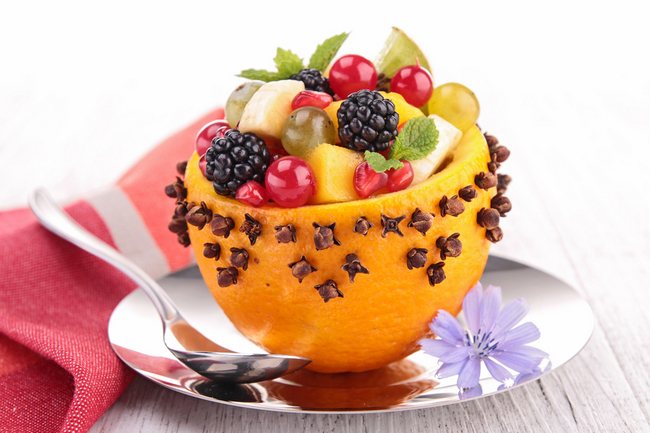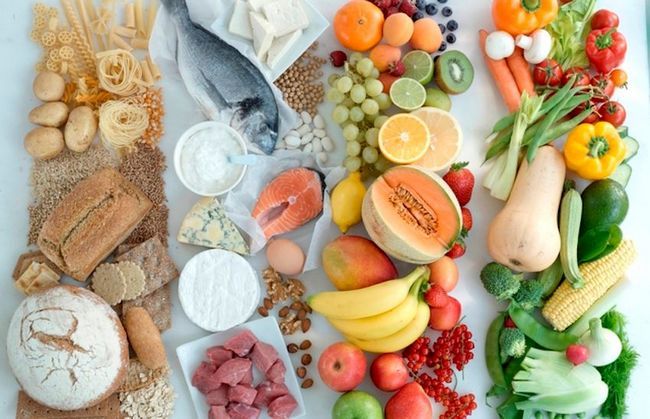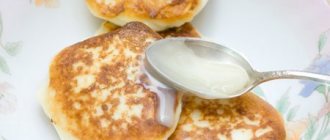The name “low-calorie breakfast” speaks for itself - the essence of such a breakfast is to limit the calories consumed in food. Limiting calories in your diet is one of the simple and natural ways to get rid of extra pounds and cleanse your body.
However, you should limit yourself in calories wisely, not forgetting about vitamins and water. According to experts, a low-calorie breakfast should contain about 250 - 330 kcal.
We offer a menu of 40 low-calorie breakfasts. Calorie content 220-330 kcal.
1. 200 g of oatmeal with water, 1 apple, a cup of green or black tea without sugar.
2. 1 boiled egg, 2 breads, coffee or tea without sugar.
3. 200 g of buckwheat porridge in water without sugar, tea with lemon and a teaspoon of honey.
4.1 soft-boiled egg, toast with a thin layer of butter, half a grapefruit, a cup of black (green) tea or coffee without sugar.
5. 200 g of wheat porridge, 1 glass of orange juice.
6. 250g coffee with milk (not fatty) without sugar. Low-calorie cottage cheese 200g.
7.Tea without sugar (can be with milk) 250g, fried pike perch 100g.
8. Coffee without sugar, with milk 250g, 2 boiled eggs.
9. Tea without sugar 250g, ham (preferably low-fat) 100g.
11. Coffee without sugar with milk 250g, pork (beef) cutlet 100g.
12. Tea with 1-2 teaspoons of honey. After 2 hours, you can eat 40 g of 17% cheese, or 100 g of cottage cheese.
13 Tea with 1-2 teaspoons of honey. After 2 hours, you can eat 75 g of meat, or 100 g of cottage cheese.
14. Tea with 1-2 teaspoons of honey and lemon. After 2 hours, you can eat 30 g of cheese and crisps or 2 pharmacy breads, or 80 g of cottage cheese with bread.
15. Tea with 1-2 teaspoons of honey. After 2 hours, you can eat 75 g of meat, or 100 g of cottage cheese.
16. Tea with 1-2 teaspoons of honey and lemon. After 2 hours, you can eat 30 g of cheese and crisps or 2 pharmacy breads, or 80 g of cottage cheese with bread.
17.Cotted cottage cheese – 100 g, stewed carrots – 200 g, coffee with milk without sugar – 200 g.
18. Fresh cabbage salad without salt with sour cream – 170 g.
19. Hercules with vegetable oil (200 g); egg; black tea with honey and a slice of lemon; apple
20. 125 g yogurt without filler; wholemeal bread
21. 200 g buckwheat porridge with vegetable oil; 200 g sauerkraut salad; black tea with honey and lemon
22. 150 g rice; 200 g assorted vegetables; black tea with honey and a slice of lemon
23. boiled egg; 200 g of boiled beet salad with vegetable oil; black tea with honey and a slice of lemon, 200 g of rolled oats; tomato or cucumber - fresh or pickled; bread; tea with honey and a slice of lemon
24. 200 g rice; 100 g boiled veal; tea with honey and a slice of lemon
25. Oatmeal with water 3 tbsp. spoons, skim milk 200 g or low-fat yogurt without sugar 200 g, half a grapefruit or a medium banana or 2 tbsp. spoons of raisins
25. Skim milk 200 g or low-fat sugar-free yogurt 200 g, unsweetened cornflakes 3/4 cup, medium banana or glass of orange/grapefruit/pineapple juice
26. Toast from bran bread with 1 tbsp. spoon of light butter, fruit milkshake, mix 200 ml skim milk with half a very ripe banana, add vanilla
27. Skim milk 200 g or low-fat sugar-free yogurt 200 g, sugar-free cornflakes 3/4 cup, medium banana or glass of orange/grapefruit/pineapple juice
28. Skim milk 200 g, sugar-free corn flakes 3/4 cup, orange or 2 tbsp. spoons of raisins
29. Oatmeal with water 3 tbsp. spoons, skim milk 200 g or low-fat yogurt without sugar 200 g, half a grapefruit or a medium banana or 2 tbsp. spoons of raisins
30. Half a grapefruit or a whole orange or a medium banana, 200 g skim milk, 3/4 cup sugar-free corn flakes
31. Oatmeal with water 3 tbsp. spoons, skim milk 200 g or low-fat yogurt without sugar 200 g, half a grapefruit or a medium banana or 2 tbsp. spoons of raisins
32. Bran bread toast with 1 tbsp. spoon of light butter, fruit milkshake, mix 200 ml skim milk with half a very ripe banana, add vanilla
33. Half a grapefruit or an orange or a glass of pineapple juice, 200 g skim milk, 3/4 cup sugar-free corn flakes
34. Oatmeal with water (from 100 g of dry flakes), 1 tablespoon of raisins, green tea or black coffee without sugar
35. 100 g boiled buckwheat with 1 tbsp. l. vegetable oil, green tea or black coffee.
36. 1 boiled egg, 2 grain breads, green tea or coffee.
37. 1 grapefruit, oatmeal (like on Monday), green tea or coffee.
38. 60 g dried apricots, 2 grain loaves, 30 g cheese (17% fat), green tea or coffee.
39. 100 g of boiled buckwheat with 1 tablespoon of vegetable oil, green tea.
40. 200 g of cottage cheese (0% fat), 100 g of fresh or frozen berries, tea or coffee.
The site was told about what a healthy breakfast should be by the portal's experts - the chief physician of the Treatment and Rehabilitation Center of the Ministry of Health and Social Development of Russia and a dietitian of the highest category at the Clinic of the Institute of Nutrition of the Russian Academy of Medical Sciences, Elena Chedia.
How much should you eat for breakfast?
It is believed that in the first half of the day you need to eat most of the food, in the second - less.
That is, breakfast should be quite hearty. For an average person with an average calorie intake of 2000 per day, the calorie content of breakfast should be approximately 400 kcal
, and a snack – 200 kcal.
If you want to know a more accurate figure, use our calculator and determine your daily energy requirement. Breakfast should account for 20 percent of the daily requirement, and snacks should account for 10 percent.
What should you eat?
Want to keep your stomach light after breakfast? Elena Chedia advises eating mainly carbohydrates. If you know that you won’t be able to eat for a long time after breakfast, the ideal option is protein dishes with a vegetable side dish.
in a ratio of 1:3.
A side dish is required because fiber ensures intestinal function. In addition, the side dish itself is large in volume, it fills the stomach and promotes a feeling of fullness. It is better to eat meat boiled or steamed - it is easier to digest. Such breakfasts are convenient because you can finish the food that is left over from dinner or lunch.
Are you already hungry, but it’s far from lunch?
Snacks in general and second breakfast in particular are very beneficial for the body. “They empty the gallbladder in a timely manner and reduce the load on the pancreas: it has to produce less insulin at a time, which reduces the risk of pancreatitis. Those who have an afternoon snack reduce the load on the enzyme system and heart,” says Elena Chedia.
The calorie content of a snack between breakfast and lunch should be about 10 percent
daily ration. There can be many options for such a snack. Here are a few of them:
- Big apple; — Light salad of cucumbers, tomatoes and lettuce; — Green tea with honey;
— A jar of yogurt without sugar and fruit additives; - One or two bananas; — Sandwich made of bran bread with cream cheese, lettuce and tomatoes; - A glass of kefir; — A small amount of dried fruits.
So, the main thing is not to skip breakfast and get used to the fact that in the morning you have one of the two main meals of the day. A hearty breakfast will help you control your portions at lunch, hold out for a snack, and not overeat at night. And, of course, it will give you strength for the whole day and help you finally wake up. We will publish recipes and examples of healthy breakfast menus compiled by our experts on the portal on October 9.
Any competent weight loss must combine a balanced healthy diet and regular physical activity. But to organize the right diet, you need to know how many calories you should consume daily to lose weight. Along with these indicators, you should also consider the amount of fats, proteins and carbohydrates entering your body for its proper functioning. If you know all these characteristics, it will be easy for you to achieve correct, but most importantly, effective results. In today's material we will introduce you to the information listed and tell you how calories are calculated.
Recipes
Let's look at a few of the most popular breakfasts with calories listed. And first of all, these are porridge recipes, with which nutritionists recommend starting the morning.
Oatmeal with kefir (102 kcal)
- Pour kefir over the oatmeal in the evening.
- Add salt in the morning.
- Add finely chopped apples, any berries or chopped nuts.
Buckwheat porridge on water (107 kcal)
- a glass of buckwheat;
- 500 ml water;
- salt.
- Sort the grains, rinse in several waters.
- Pour in cold water, bring to a boil, cook until tender.
- Add some salt.
Smoothie (60 kcal)
- 4 things. fresh strawberries;
- half an apple;
- 100 ml low-fat kefir;
- 30 g oatmeal;
- some nuts.
- Peel and core the apple. Cut into cubes.
- Combine strawberries, apple and oatmeal in a blender. Beat for 1 minute.
- Add kefir. Beat for another 1-1.5 minutes.
- Sprinkle chopped nuts on top.
Omelette with vegetables (130 kcal)
- 2 eggs;
- a little olive oil;
- 1 sweet pepper;
- 1 small tomato;
- 50 g zucchini;
- 20 g parsley;
- 50 ml low-fat milk;
- salt.
- Beat the eggs in a bowl with a whisk, add milk. Beat again until foam forms. Add some salt.
- Pour the egg-milk mixture onto a baking sheet with olive oil.
- Cut the pepper into strips, zucchini into cubes, tomatoes into slices. Place on a baking sheet. Mix everything.
- Place in a preheated oven for 5-7 minutes.
- Sprinkle chopped parsley on top.
Fruit salad (80 kcal)
Ingredients (50 g each):
- apples;
- pears;
- pomegranate;
- avocado;
- grape;
- peaches;
- a pineapple;
- 300 ml natural yogurt.

- Wash the fruits thoroughly, remove peels and seeds.
- Grind into small cubes.
- Mix.
- Pour over yogurt.
- Mix.
- Sprinkle pomegranate seeds on top.
Carrot muffin with raisins (147 kcal)
- 150 ml kefir;
- 1 egg;
- 1 medium-sized carrot;
- 1 medium-sized apple;
- 20 g raisins;
- a little soda;
- 90 g wheat flour;
- 90 g oat flour.
- Peel and seed the apple.
- Grate it and carrots.
- Quench soda with kefir.
- Add egg, apple and carrots to it.
- Add both types of flour.
- Stir in raisins.
- Knead.
- Pour into molds.
- Bake for 40 minutes in the oven at 180°C.
Delicious recipe! Meringue and sponge cake recipe
Poached egg (28 kcal)
- 2 eggs;
- 500 ml water;
- 10 ml lemon juice;
- salt.
- Pour water into a saucepan, boil, add salt, add lemon juice. Reduce heat.
- Break the egg into the cup very carefully so as not to spread.
- Create a water funnel with a spoon and pour the egg into it.
- Cook for 4 minutes.
- Remove with a slotted spoon.
The most delicious recipes for dietary breakfasts are there, the best options for weight loss have been sorted out, the TOP of the best has been compiled - now all that remains is to put all this theoretical information into practice.

Breakfast is considered an important part of the whole day. But does this mean that you should eat the most nutritious foods in the morning? Exactly how many calories should you consume to lose weight, and what should your breakfast be? The answer depends on several factors.
The opinion of nutritionists about the calorie content of meals
So, in order to know how many calories to consume for weight loss, it is important to consider many factors. On average, it is believed that for women their daily norm ranges from 2100 to 3000 kcal, and for men - from 2600 to 3200 kcal. However, experts in the field of weight management say that in fact it is not worth reducing your daily calorie intake to less than 1,500 units. This figure includes three full meals. But for weight loss it is considered quite small, and in order for the weight to begin to go away, you should also take care of physical training.
Let's pay special attention to the meals mentioned above. After all, they, in fact, are the basis for determining how many calories you need to lose weight. According to nutritionists, breakfast should include a variety of types of cereals. Cereals are especially useful. They contain slow carbohydrates that will supply us with energy and within 3-4 hours our body will not be able to feel hunger. It’s good to eat oatmeal, buckwheat or a mixture of 4 grains for breakfast. And they need to be cooked with water, not milk. This way you can reduce the calorie content of the dish. To add flavor to the porridge, you can add fruit or a small amount of low-fat yogurt.
Lunch will indicate how many calories you consume to lose weight. According to nutritionists, this particular meal should be complete and satisfying. At this time, it is important for the body to get enough proteins and carbohydrates. Therefore, at lunch it is recommended to eat soups and main courses, for example, meat or fish with side dishes, that is, with vegetables. Proteins, as medical experts explain, give us a feeling of fullness, and carbohydrates provide us with normal functioning. After all, if a person receives less than 70 g of carbohydrates, then fainting, nervous breakdowns and increased fatigue may occur.
Dinner must take place no later than 7 pm. Because at a later time our body loses the ability to properly absorb and process incoming food. And here it is worth paying attention to how many calories you consume. To lose weight, there should not be too many of them, that is, it is better to cook light meals for dinner. After all, everything that does not have time to be properly digested in the stomach will go into subcutaneous fat accumulation. Therefore, for dinner it is best to use carbohydrate dishes with a glycemic index below 50 or any protein products that are not too fatty.
Are corn flakes more beneficial or harmful to the body?
Corn flakes are a convenient and inexpensive breakfast option for children and adults. Some consider cereal to be a healthy dish, while others are sure that it is not a valuable product, but, on the contrary, harmful to the body.
To figure out whether cereal is healthy or harmful, let’s look at the composition and evaluate the calorie content of the product in its pure form (without sugar) and with sugar.
The composition of corn flakes includes macro- and microelements: cobalt, sodium, potassium, zinc, magnesium, copper. It also contains fiber, vitamins of groups A, B1, B2, E, H, PP, starch and amino acids. Some manufacturers enrich finished corn flakes with synthetic vitamins that have little beneficial properties.
Table of the chemical composition of corn flakes and their nutritional value per 100 g of product:
| Composition characteristics | Quantitative indicators | Percentage of the norm in 100 g |
| Calorie content | 325.3 kcal | 19.3% |
| Squirrels | 8.3 g | 10.9% |
| Fats | 1.2 g | 2% |
| Carbohydrates | 75 g | 35.5% |
| Alimentary fiber | 0.8 g | 4% |
| Water | 14 g | 0.6% |
| Ash | 0.7 g | |
| Vitamins | ||
| Vitamin A, RE | 200 mcg | 22.2% |
| Retinol | 0.2 mg | |
| Vitamin B1, thiamine | 0.1 mg | 6.7% |
| Vitamin B2, riboflavin | 0.07 mg | 3.9% |
| Vitamin B5, pantothenic | 0.3 mg | 6% |
| Vitamin B6, pyridoxine | 0.3 mg | 15% |
| Vitamin B9, folates | 19 mcg | 4.8% |
| Vitamin E, alpha tocopherol, TE | 2.7 mg | 18% |
| Vitamin H, biotin | 6.6 mcg | 13.2% |
| Vitamin RR, NE | 2.4778 mg | 12.4% |
| Vitamin B5, Niacin | 1.1 mg | |
| Macronutrients in milligrams (mg) | ||
| Potassium, K | 147 | 5.9% |
| Calcium, Ca | 20 | 2% |
| Magnesium, Mg | 36 | 9% |
| Sodium, Na | 55 | 4.2% |
| Sera, S | 63 | 6.3% |
| Phosphorus, Ph | 109 | 13.6% |
| Microelements in micrograms (mcg) | ||
| Aluminium, Al | 29 | |
| Bor, B | 215 | |
| Iron, Fe | 2.7 | 15% |
| Cobalt, Co | 4.5 | 45% |
| Manganese, Mn | 0.4 | 20% |
| Copper, Cu | 210 | 21% |
| Molybdenum, Mo | 11.6 | 16.6% |
| Nickel, Ni | 23.4 | |
| Tin, Sn | 19.6 | |
| Titanium, Ti | 27 | |
| Chromium, Cr | 22.7 | 45.4% |
| Zinc, Zn | 0.5 | 4.2% |
| Digestible carbohydrates in grams | ||
| Starch and dextrins | 70.4 | |
| Mono- and disaccharides (sugars) | 2 |
Here you can download a table of the composition of corn flakes.
The product's glycemic index (or the rate of absorption of carbohydrates that increase blood sugar) is 81. Sugary cereals have a GI value of 85, so people suffering from diabetes are not recommended to consume them.
The calorie content of corn flakes increases due to the addition of sugar and synthetic components to their composition, which increase shelf life and taste. 100 g of cereal contains 8.5 teaspoons of sugar.
To lower the glycemic index of breakfast corn, eat the cereal with plain yogurt or kefir.
Product benefits
Corn flakes contain substances that are beneficial to health and provide energy. This product is most useful for brain activity and the functioning of the gastrointestinal tract.
Benefits of corn flakes for the gastrointestinal tract:
benefits of breakfast cereals
In the 90s, breakfast cereals began to slowly replace ordinary Russian breakfasts, which included sandwiches or porridge with milk. What are the benefits of breakfast cereals?
Of course, time is of great value now. Few people can afford to eat a real lunch when getting ready for work.
Thanks to this, one of the indisputable advantages of breakfast cereals is their quick preparation. Simply scatter cereal or snacks into a plate, pour milk over them, and lunch is ready. Yogurt or kefir is not always used instead of milk. It is believed that dry lunch is also good for health.
After all, the method of their preparation very often makes it possible to preserve a lot of useful substances contained in cereals.
So corn flakes are rich in vitamins and E. And rice flakes contain all the practical amino acids that the body needs. Oatmeal contains a lot of phosphorus and magnesium. But absolutely not all breakfast cereals bring only benefits.
To find out which ones are much better to choose, you need to know how breakfast cereals .
Breakfast cereals: benefits and harms for children and adults
Attention! If we talk about the properties of breakfast cereals for our body, then only products that have not been subjected to heat treatment will be useful. It is in them that all the healing components remain.
Corn flakes contain a large amount of vitamin A and retinol. The rice product is rich in amino acids, and the oat product is rich in phosphorus and magnesium. Dried fruits, which are added to muesli, saturate our body with ferrum and potassium. And if they also contain nuts, such a breakfast will be perfectly absorbed by our gastrointestinal tract. In addition, nuts contain a lot of polyunsaturated acids.
Source: //GolovaNeBoli.ru/polza-i-vred/vred-i-polza-suhih-zavtrakov.html
How to count calories for weight loss
How to count calories to lose weight? Initially, you need to measure your height and weight. And then use a formula that looks like this:
- for women – 9.99 x weight (in kg) + 6.25 x height (in cm) – 4.9 x age – 161;
- For men, the calculations are similar, the only thing is that at the end you need to add the number 5 to the results obtained.
But you won’t be able to find out how many calories you need to lose weight using these formulas. Because here you should also take into account the required amount of energy in accordance with your physical activity. Therefore, additional numbers are introduced into the calculations.
So, for people who lead a sedentary lifestyle and do not engage in any sports, the results obtained in the above formulas should be multiplied by 1.2. The same category, but subject to training (say, fitness) 1-2 times a week, should be multiplied by 1.375. At an average activity level with 5 gym sessions a day, the results should be multiplied by 1.55. At a higher level of activity – by 1.725. Well, for professional athletes - 1.9.
It will become clearer about how many calories you need to lose weight using an example. To do this, we will consider a 38-year-old woman, weighing 65 kg and height 156 cm, who has the lowest level of physical activity. Based on the formula, we get the following results:
9.99 x 65 + 6.25 x 156 – 4.9 x 38 – 161 = 1289 kcal.
But for the full functioning of the body, this number will be:
1289 x 1.2 = 1547 kcal.
In the example considered, the woman is overweight, so in order to lose weight, her daily calorie intake should be reduced. How to do this correctly? You just need to reduce the resulting daily norm by 1/5, which will be 309 kcal. And the final calorie content for weight normalization will be 1238 kcal. That's all the calculations. And remember that your diet cannot be less than 1200 kcal per day. The results of such experiments are often accompanied by negative consequences.
The calorie content of food is a very important indicator when choosing food. For each meal there is a certain calorie limit that must be adhered to to maintain health and energy. How many calories should you eat for breakfast?
We'll find out now.
Calorie content of food
- these are not just numbers on the label that will tell us how much we will gain by consuming this or that product. Every day we eat food with a certain calorie content, and every day we spend a certain amount of calories (energy). This involves all the processes that happen to us, including sleep, rest, food, etc. If we eat more calories than we expend, the body stores them and we become overweight. It is also not necessary to limit the caloric content of food too much; in this case, the body begins to take energy from tissues, including muscles. And we don’t want this, because muscles have a positive effect on the process of losing weight.
Product Lists
Well, now directly the lists of products, what is best to eat for breakfast, and what is strictly prohibited when losing weight.
Can:
- green tea;
- boiled chicken breast (especially useful for athletes, as it contains a lot of animal protein for the formation of beautiful muscle mass);
- honey is a natural energy drink;
- milkshakes;
- coffee (but only drunk after breakfast, not before);
- olive oil;
- nuts;
- healthy cereals (buckwheat and rolled oats above all) - those slow carbohydrates that promote weight loss;
- fresh fruits with minimal sugar content;
- cheese, low-fat kefir - an ideal combination of protein and calcium;
- Fresh juices and smoothies are sources of vitamins;
- bread - rye bran or whole grain, toast;
- eggs and any dishes made from them are a source of protein and vitamins.
Delicious recipe!
Shortbread cookies Soviet recipe You cannot:
- bananas - oddly enough, also fall into this list, and not only because of the high sugar content: excess magnesium in the morning disrupts the internal balance of the body;
- bacon, sausages and sausages;
- fat meat;
- yoghurts with colors and flavors;
- canned food;
- smoked meats;
- mayonnaise, ketchup, soy sauce, vinegar;
- pasta;
- carbonated, energy and alcoholic drinks;
- marinades, pickles;
- some diets suggest eating grapefruits for breakfast, while citrus fruits on an empty stomach are the right path first to heartburn, then to gastritis, and in the future to ulcers;
- dumplings;
- pies, pancakes, pancakes, donuts and other baked goods;
- fish;
- fresh vegetables - on an empty stomach irritate the gastric mucosa;
- sweets (sweets, cookies, chocolate), sugar;
- spices, seasonings, onions, garlic, pepper;
- cottage cheese - nutritionists advise consuming it in the afternoon;
- fast food.

Questionable products
Nutritionists have mixed opinions about breakfast cereals: cereals, muesli and snacks. Yes, these are carbohydrates, very tasty, many people like them, they give a boost of energy and a good mood for the whole day. On the other hand, this is not the most suitable option for losing weight, because they contain too much sugar - those same fast carbohydrates that provide a short-term feeling of fullness. In just an hour you will want to eat again. If you like muesli, then at least eat it with fruit and low-fat kefir.
The second list is quite relative. To avoid a breakdown, you can allow yourself some fast carbohydrates once a week in a small amount. In the absence of other indulgences, a spoonful of jam or a fresh scone will not make you fatter or derail your weight loss plan.
How many calories should you eat for breakfast?
Breakfast is considered the most important meal of the day, especially if you are trying to lose weight. It is an indisputable fact that breakfast should account for 40% of the calorie content of all food that we eat throughout the day. The calorie content of foods directly depends on the content of proteins, fats and carbohydrates in them. Fats and simple carbohydrates will add calories to the product; they are digested very quickly and go into fat, which is not very pleasant. So how many calories should you eat for breakfast? It is very good if you have two breakfasts: the first immediately after waking up and the second breakfast 2-3 hours later, which will be very light and quick. An ideal breakfast should consist of carbohydrates and proteins; fats may be present, but in very limited quantities. The calorie content of the first breakfast should be approximately 350 kcal. The calorie content of the second breakfast should not exceed 220 kcal.
Principles of proper nutrition and breakfast menu
A healthy breakfast should contain a sufficient amount of calories (skipping breakfast does not bode well; you will be irritable and lacking energy until lunch), and be balanced (contain proteins, fats, carbohydrates, dietary fiber, vitamins and minerals).
It is impossible to provide such a balance with one or two products. If you seem to have completely broken the breakfast habit, get into the habit of breakfast by starting with fruit for breakfast.
Let's consider possible breakfast options.
Squirrels.
A certain amount of protein (not completely complete) is contained in plant products. If you haven't planned a cutlet, egg or omelet for breakfast, you need to cook the porridge with milk or make a sandwich with cheese.
An omelet or scrambled eggs can be made from 2-3 eggs, provided that you do not consume more eggs during the week. If you love cottage cheese (and have not convinced yourself that it is necessary for weight loss), then buy only cottage cheese with a fat content of 5% or higher - cottage cheese with a lower fat content is a surrogate and is not able to provide you with calcium.
You can add honey or sour cream to cottage cheese, as well as raisins or chopped dried apricots - an excellent source of potassium to support the heart muscle and normalize water metabolism. You can make a casserole from cottage cheese.
Avoid cheap types of sausage completely - sausage is not a food product, but a delicacy (the highest varieties) for serving on a festive table. Also avoid sausages.
You can replace the breakfast dish with a glass of fermented milk drink - it could be kefir or fermented baked milk. Never add sugar - it's a waste of calories. A glass of good fermented milk product in the morning will normalize your digestion until lunch.
Do not replace natural fermented milk products (which you can prepare yourself the night before) with store-bought ones.
Fats.
Breakfast must contain a small amount of fat. This can be vegetable or butter in the porridge (if the porridge is made with water), or prepare a sandwich with butter. Season salads with vegetable oil (preferably olive oil) or low-fat sour cream.
A teaspoon of flaxseed or camelina oil will provide you with your daily requirement of omega-3 fatty acids. It is better not to use mayonnaise, natural one is too high in calories, and low-calorie ones are surrogates.
Carbohydrates and dietary fiber.
Carbohydrates should be complex. The ideal breakfast dish is oatmeal, buckwheat porridge or brown rice. For variety, cook other cereals from time to time.
Porridges are cooked from whole grains that do not lack fiber-containing shells. You can add berries to the porridge, fresh or from the freezer. 35 g of blackcurrant will provide you with your daily requirement of vitamin C.
Try not to add salt to the porridge; you get used to the lack of salt in it very quickly. You will receive the amount of salt you need with purchased bread.
Instant porridges and cereal porridges cannot be considered a healthy diet; such food is devoid of essential nutritional components.
Sandwiches are best made from whole grain bread or wholemeal bread, which contains fiber.
When buying bread, pay attention to the composition - premium wheat flour should not be in the first place in the list of ingredients. Instead of bread, you can eat a piece of pita bread.
If you include honey in your breakfast menu, it is better to eat it from a spoon, do not add it to hot porridge or tea; when heated, honey loses all its healing properties.
It is quite possible to prepare vegetable or fruit salads for breakfast. It is possible to add seeds or nuts to salads. Greens can also serve as a source of fiber for breakfast.
Store-bought muesli is not the best option for breakfast, and it is often high in low-quality fats, and the fruit is candied for preservation. Avoid breakfast cereals (cushions), instant soups and purees, despite the speed of their preparation. This is food at best for a field breakfast in camping conditions.
Beverages.
Drink only natural tea or coffee. Do not drink coffee substitutes, do not add sugar to tea/coffee - then you will have a reserve of simple carbohydrates in the form of candy, marshmallows or a slice of chocolate for second breakfast, afternoon tea or dinner.
A slice of lemon with your tea will give it some piquancy and mask the lack of sugar. Never use synthetic sweeteners. Do not drink store-bought fruit juices or nectars at breakfast - they are oversaturated with sugar.
Lunch.
The second breakfast (or snack) should complement the first; it should not include dishes that were already part of the first breakfast. And if you are not yet accustomed to eating a full first breakfast, a second breakfast is simply necessary.
The calorie content of a second breakfast, if available, for those losing weight is no higher than 200-300 kcal, depending on the daily calorie content.
What can be included in this calorie content? A glass of fermented milk drink (if you didn’t drink kefir with your first breakfast) will already cost 75-100 kcal. The remaining 100-200 kcal is a sandwich with cheese or chicken with cucumber. For second breakfast, a single product is also possible.
Fruit, apple, orange or banana are a good second breakfast. 40 g of peanuts or other nuts will completely cover the calorie content of a second breakfast.
You should not resort to fast food, baked goods, or cakes as a second breakfast, although this becomes difficult if the second breakfast is a ritual tea party in the office between the start of the working day and lunch.
Show character, you decided to lose weight. Limit yourself to a glass of tea (without sugar) and a slice of black bread with butter.
Based on ideas about the healthfulness and unhealthiness of foods, you can create many breakfast options, calculate them and write them down with calorie content, this will make it easier for you to lose weight and allow you not to go beyond the target daily calorie intake.
We bring to your attention the following video:
Fitness trainer, group exercise instructor, nutritionist
Provides general consultations on nutrition, selection of a diet for pregnant women, weight correction, selection of nutrition for exhaustion, selection of nutrition for obesity, selection of an individual diet and therapeutic nutrition. Also specializes in modern methods of functional testing in sports; athlete recovery.
Of course, every girl who watches her figure has at least once thought about the question of what to eat in order to get the necessary portion of vitamins and nutrients and at the same time not gain weight. Let's figure out whether breakfast is necessary and what foods are best for it.
“Eat breakfast yourself...”
Nutritionists around the world, answering the question of what breakfast is for, note that breakfast is one of the main meals. If you deprive yourself of breakfast, your body will not produce a vital substance - insulin. Thanks to it, we become alert and overcome sleep in the morning. Eating in the morning stimulates the brain and the body as a whole, setting it up for work throughout the day. In addition, if you eat properly in the morning, you won’t have to limit yourself in food at lunchtime.
The Healthiest Breakfast Foods
Now let's figure out what you should eat for breakfast and what you should avoid. One of the healthiest morning meals can be considered oatmeal or muesli with fruits or nuts. These products are low in calories and very nutritious. Eggs are no less healthy for breakfast, but it is better to make an omelette with vegetables or boil them rather than fry them, as they contain too much fat. You can also make a sandwich from rye bread and cheese. For dessert, it is very good to use honey in small quantities. It is better to drink juice, yogurt or coffee; they should be separated during the meal, for example, washed down with juice during the main meal, and leave the coffee for the very end. You should not start your morning with sausages, smoked meats and other heavy foods.
How many calories do you need for breakfast?
If we talk about the calorie content of the morning meal, then in order not to harm the figure, breakfast should be no more than 25% of the average daily amount of calories. For the average person, this amounts to 150 – 200 kcal per morning. It is also possible to make a second breakfast if you have an early breakfast. It should be no more than 10% of the daily value, therefore, no more than 50 kcal.
Breakfast is considered an important part of the whole day. But does this mean that you should eat the most nutritious foods in the morning? Exactly how many calories should you consume to lose weight, and what should your breakfast be? The answer depends on several factors.
Before determining the number of calories for breakfast for weight loss, you need to find out how many you will need for the whole day. Each person's needs are different. The total number of calories you consume per day is based on your resting metabolic rate and activity level. If a person is trying to lose weight, they reduce the number of calories they consume to achieve the negative energy balance needed for weight loss.
To calculate the recommended rate, you can use an online calculator or perform simple calculations yourself. Finding out the recommended indicators is useful even for those who do not set out to count calories for weight loss. This will give you an idea of how much you should eat per serving, including breakfast.
Once your daily caloric intake is known, this number should be divided by all meals, including snacks. The methods of separation depend on each person’s lifestyle, activity, habits and eating patterns.










